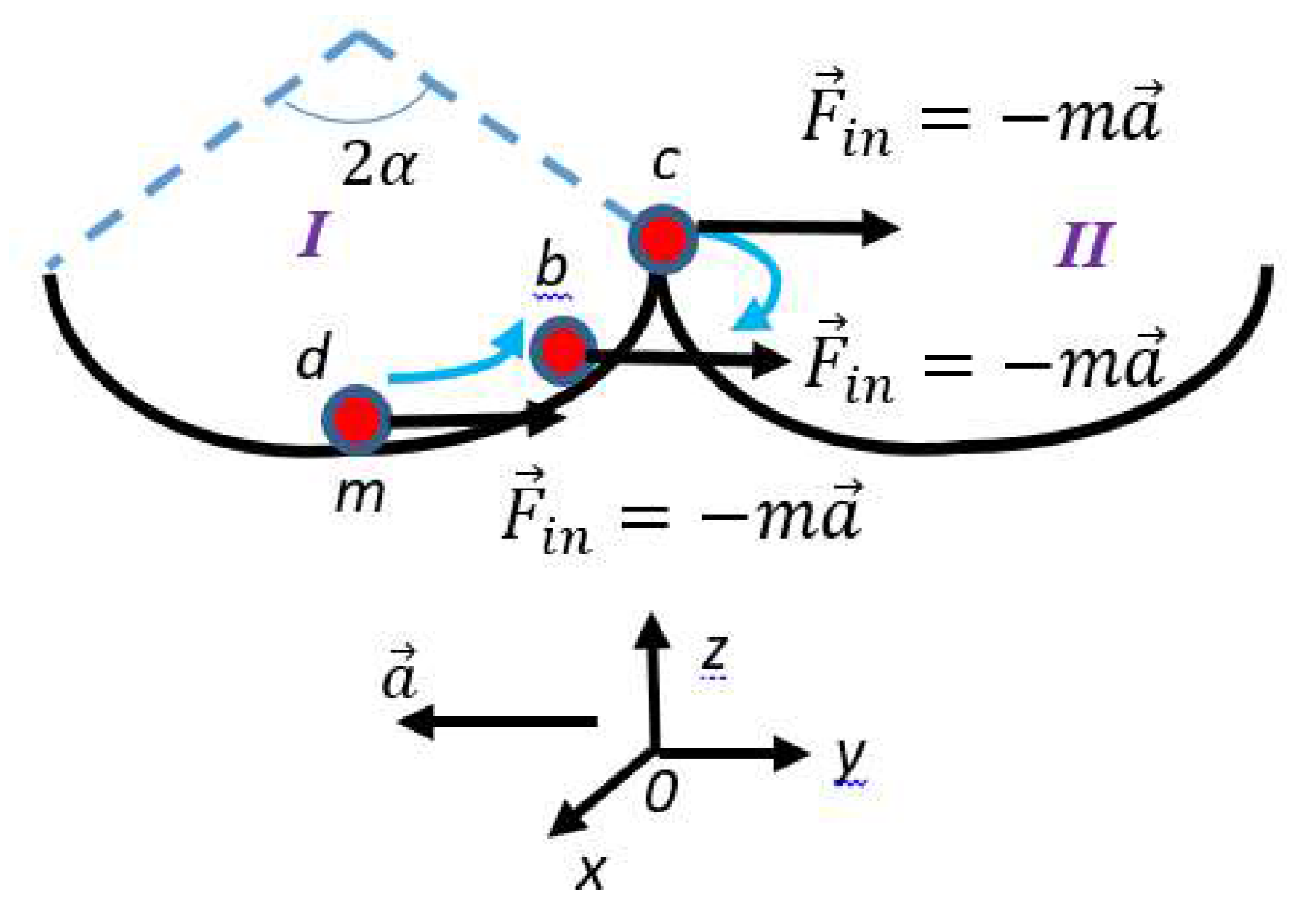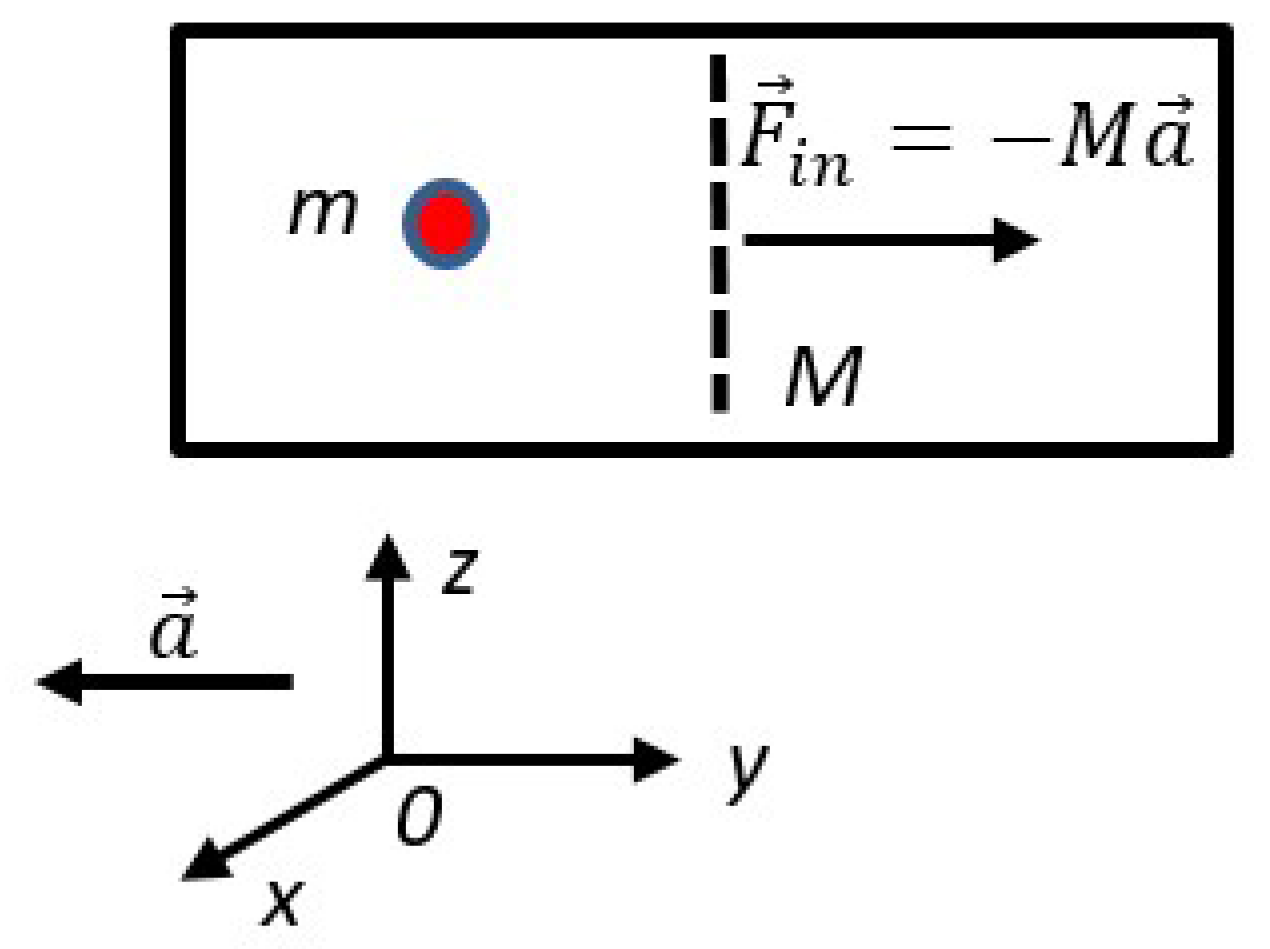Informational Reinterpretation of the Mechanics Notions and Laws
Abstract
1. Introduction
2. Results and Discussion
2.1. Informational Reinterpretation of the First Newton Law
2.2. The Landauer Principle and Noninertial Frames of Reference
2.3. The Informational Reinterpretation of the Equivalence Principle
3. Conclusions
Funding
Acknowledgments
Conflicts of Interest
References
- Kucia, R.A. Landauer’s principle as a special case of galois connection. Entropy 2018, 20, 971. [Google Scholar] [CrossRef]
- Bérut, A.; Arakelyan, A.; Petrosyan, A.; Ciliberto, S.; Dillenschneider, R.; Lutz, E. Experimental verification of Landauer’s principle linking information and thermodynamics. Nature 2012, 483, 187–189. [Google Scholar] [CrossRef] [PubMed]
- Herrera, L. The Gibbs paradox, the Landauer principle and the irreversibility associated with tilted observers. Entropy 2017, 19, 110. [Google Scholar] [CrossRef]
- Vopson, M.M. The mass-energy-information equivalence principle. AIP Adv. 2019, 9, 095206. [Google Scholar] [CrossRef]
- Diamantini, M.C.; Trugenberger, C.A. Generalized Landauer bound as a universal thermodynamic entropy in continuous phase transitions. Phys. Rev. E 2014, 89, 052138. [Google Scholar] [CrossRef]
- Landauer, R. Dissipation and heat generation in the computing process. IBM J. Res. Dev. 1961, 5, 183. [Google Scholar] [CrossRef]
- Landauer, R. Information is physical. Phys. Today 1991, 44, 23–29. [Google Scholar] [CrossRef]
- Landauer, R. Minimal energy requirements in communication. Science 1996, 272, 1914–1918. [Google Scholar] [CrossRef]
- Norton, J.D. Eaters of the lotus: Landauer’s principle and the return of Maxwell’s demon. Stud. Hist. Philos. Sci. Part B Stud. Hist. Philos. Mod. Phys. 2005, 36, 375–411. [Google Scholar] [CrossRef]
- Norton, J.D. Waiting for Landauer. Stud. Hist. Philos. Mod. Phys. 2011, 42, 184–198. [Google Scholar] [CrossRef]
- Wheeler, J.A. Information, physics, quantum: The search for links. In Proceedings of the 3rd International Symposium on Foundations of Quantum Mechanics in the Light of New Technology, Tokyo, Japan, 28–31 August 1989; pp. 354–368. [Google Scholar]
- Herrera, L. The mass of a bit of information and the Brillouin’s principle. Fluct. Noise Lett. 2014, 13, 14500. [Google Scholar] [CrossRef]
- Bormashenko, E. The Landauer principle: Re-formulation of the second thermodynamics law or a step to great unification? Entropy 2019, 21, 918. [Google Scholar] [CrossRef]
- Ben Naim, A. Shannon’s measure of information and Boltzmann’s H-theorem. Entropy 2017, 19, 48. [Google Scholar] [CrossRef]
- Ben-Naim, A. Information Theory; World Scientific: Singapore, 2017. [Google Scholar]
- Ben-Naim, A. A Farewell to Entropy: Statistical Thermodynamics Based on Information; World Scientific: Singapore, 2008. [Google Scholar]
- Ben-Naim, A. Entropy, the Truth the Whole Truth and Nothing but the Truth; World Scientific: Singapore, 2016. [Google Scholar]
- Ben-Naim, A. Entropy and information theory: Uses and misuses. Entropy 2019, 21, 1170. [Google Scholar] [CrossRef]
- Knuth, K.H. Information-Based Physics and the Influence Network. In It from Bit or Bit from It? Aguirre, A., Foster, B., Merali, Z., Eds.; Springer: Cham, Germany, 2015. [Google Scholar]
- Knuth, K.H.; Walsh, J.L. An introduction to influence theory: Kinematics and dynamics. Ann. Phys. 2019, 531, 1800091. [Google Scholar] [CrossRef]
- Caticha, A. Entropic dynamics. Entropy 2015, 17, 6110–6128. [Google Scholar] [CrossRef]
- Verlinde, E. On the origin of gravity and the laws of Newton. J. High Energy Phys. 2011, 29, 2011. [Google Scholar] [CrossRef]
- Plastino, A.; Rocca, M.C. Entropic forces and newton’s gravitation. Entropy 2020, 22, 273. [Google Scholar] [CrossRef]
- Kobakhidze, A. Gravity is not an entropic force. Phys. Rev. D 2011, 83, 021502. [Google Scholar] [CrossRef]
- Müller, J.G. Information contained in molecular motion. Entropy 2019, 21, 1052. [Google Scholar] [CrossRef]
- Earman, J.; Friedman, M. The meaning and status of Newton’s Law of inertia and the nature of gravitational forces. Philos. Sci. 1973, 4, 329–359. [Google Scholar] [CrossRef]
- Landau, L.; Lifshitz, E.M. The Classical Theory of Fields, 4th ed.; Butterworth-Heinemann: Oxford, UK, 1975; Volume 2. [Google Scholar]
- Sagawa, T.; Ueda, M. Minimal energy cost for thermodynamic information processing: Measurement and information erasure. Phys. Rev. Lett. 2009, 102, 250602. [Google Scholar] [CrossRef] [PubMed]
- Parrondo, J.M.R.; Horowitz, J.M.; Sagawa, T. Thermodynamics of information. Nat. Phys. 2015, 11, 131–139. [Google Scholar] [CrossRef]
- Bormashenko, E. Generalization of the Landauer Principle for computing devices based on many-valued logic. Entropy 2019, 21, 1150. [Google Scholar] [CrossRef]
- Szilard, L. Über die Entropieverminderung in einem thermodynamischen System bei Eingriffen intelligenter Wesen. J. Phys. 1929, 53, 840–856. (In German) [Google Scholar]
- Lutz, E.; Ciliberto, S. Information: From Maxwell’s demon to Landauer’s eraser. Phys. Today 2015, 68, 30–35. [Google Scholar] [CrossRef]
- Bormashenko, E.; Shkorbatov, A.; Gendeman, O. The Carnot engine based on the small thermodynamic system: Its efficiency and the ergodic hypothesis. Am. J. Phys. 2007, 75, 911–915. [Google Scholar] [CrossRef]
- Goldstein, H. Classical Mechanics; Addison-Wesley Publishing Co.: Boston, MA, USA, 1959. [Google Scholar]
- Baierlein, R. Thermal Physics; Cambridge University Press: Cambridge, UK, 1999. [Google Scholar]
- Landau, L.D.; Lifshitz, E.M. Statistical Physics, 3rd ed.; Course of Theoretical Physics; Elsevier: Oxford, UK, 2011; Volume 5. [Google Scholar]
- Ohanian, H. What is the principle of equivalence? Am. J. Phys. 1977, 45, 903. [Google Scholar] [CrossRef]
- Roll, P.G.; Krotkov, R.; Dicke, R.H. The equivalence of inertial and passive gravitational mass. Ann. Phys. 1964, 26, 442–517. [Google Scholar] [CrossRef]
- Tolman, R.C. Relativity, Thermodynamics and Cosmology; Oxford University Press: Oxford, UK, 1934. [Google Scholar]
- Ott, X. Lorenz-transformation der waerme and der temperatur. J. Phys. 1963, 175, 70–104. (In German) [Google Scholar]
- Bekenstein, J. Universal upper bound on the entropy-to-energy ratio for bounded systems. Phys. Rev. D 1981, 23, 287–298. [Google Scholar] [CrossRef]
- Bekenstein, J. How does the entropy/information bound work? Found. Phys. 2005, 35, 1805–1823. [Google Scholar] [CrossRef]


© 2020 by the author. Licensee MDPI, Basel, Switzerland. This article is an open access article distributed under the terms and conditions of the Creative Commons Attribution (CC BY) license (http://creativecommons.org/licenses/by/4.0/).
Share and Cite
Bormashenko, E. Informational Reinterpretation of the Mechanics Notions and Laws. Entropy 2020, 22, 631. https://doi.org/10.3390/e22060631
Bormashenko E. Informational Reinterpretation of the Mechanics Notions and Laws. Entropy. 2020; 22(6):631. https://doi.org/10.3390/e22060631
Chicago/Turabian StyleBormashenko, Edward. 2020. "Informational Reinterpretation of the Mechanics Notions and Laws" Entropy 22, no. 6: 631. https://doi.org/10.3390/e22060631
APA StyleBormashenko, E. (2020). Informational Reinterpretation of the Mechanics Notions and Laws. Entropy, 22(6), 631. https://doi.org/10.3390/e22060631




